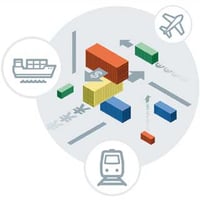Leveraging Best Practices for Global Freight Management
Nick Ostdick - April 14, 2016

For companies operating in just one country, creating transportation visibility and efficient freight management processes is a fairly actionable goal. Regulations, tariffs, and compliance restrictions are often identical across the board, so planners and managers can focus on more local objectives such as fuel costs, routing, and FTL (Full Truckload) vs. LTL (Less Than Truckload).
 But we’ve seen in recent years the march of globalization and the emergence of new and previously under-served markets, and companies looking to break into these markets or operate in multiple countries will have to critically examine best practices and strategies for global freight management.
But we’ve seen in recent years the march of globalization and the emergence of new and previously under-served markets, and companies looking to break into these markets or operate in multiple countries will have to critically examine best practices and strategies for global freight management.
Creating a lasting, substantive business footprint in more than one country comes down to end-to-end visibility, transparency, and agility in a company’s overall supply stream, including the manufacturing, distributing, shipping, and sales sectors. A large part of creating optimal supply and shipping pipelines is managing the often erratic and hidden costs of moving products between borders through a variety of different modes – rail, air, and chassis.
In today’s complex, global marketplace, companies without a thorough and vetted global freight management strategy can quickly find themselves hemorrhaging resources. If unchecked, these complex logistics – which can account for nearly 10 percent of a company’s revenue, which runs nearly 2 to 3 times that of domestic logistics – can not only be a drag on a company’s end-to-end supply capabilities, but can also result in significant decreases in the quality of customer relationships, revenue, and growth.
With that in mind, here are a few best practices to leverage when considering how to best implement a global freight management strategy.
 Review/Consolidate Carrier Options
Review/Consolidate Carrier Options
Consolidating international carrier options will allow supply chain managers and planners to leverage maximum discounts without compromising service. In addition, consolidating carriers will afford those within the supply and freight pipeline to define a number of logistical requirements – such as dates, origins, destinations, modes – and access each contracted rate and accessorials.
If the goal of an efficient freight management strategy is transparency and visibility, consolidating and reviewing carrier options put a number of variables in black and white to help make cost-effective decisions. Utilizing a smart or optimized transport management system will provide those within the supply chain real-time access to shipping rates, routes, taxes, and other associated freight costs for side-by-side comparisons. The ability to examine the wealth of service options will enable better communication and collaboration throughout the supply stream, and foster better ROI (Return on Investment) when it comes to selecting the right carrier.
Centralize Access to Contracts and Amendments
Achieving competency in domestic or single-country freight rarely translates to the complexities of global freight management logistics. As such, it’s crucial for supply chain planners to establish a system where all carrier contract terms complete with updated rates and services are available on a worldwide scale – in short, it does a company no good for those in only one hub to access data when that data is necessary in multiple hubs across the globe.
Centralizing this information increases value-added decision-making by pulling more parts of the supply chain into the discussion when deciding on a carrier. The practices of using spreadsheets and manual tracking of contracts and amendments is no longer relevant in today’s digital, multi-national supply stream, and utilizing cloud-based and online technology to distribute a library of contracts will give planners greater confidence that all carrier agreements and amendments are current and up-to-date, which facilitates the ease of freight management audits down the line.
Establishing a centralized location for information storing will also make it easy for planners and managers to prepare for and react to potential disruptions in the supply pipeline. Unexpected weather events, port strikes, labor disputes, and other factors can result in major supply bottlenecks and breakdowns. A central information portal with multiple access points provides real-time capabilities to manage these disruptions and maintain inventory and delivery levels.
Manage Accessorials
Imagine buying a home without knowing all the fine print. Closing costs. Taxes. Attorney fees. The list goes on. It sounds ill-advised, but this is exactly the situation many planners and mangers find themselves in when it comes to global freight management and managing the associated accessorials. Much like the list price of a home, the base freight rate can be just a part of the overall shipping costs, which often include extra fees for additional services. As stated before, utilizing an optimized TMS solution can help put these “hidden” costs in play, but factoring in accessorials to each freight order will help minimize surprise or sunk costs. It will also allow for those across the supply stream to monitor carrier governing rules, tariffs, and fluctuating service rates due to external factors such as fuel costs.
Utilize Audits to Review Practices
Audits, though sometimes an arduous process, are your friend and are invaluable to monitoring and modifying a global freight management strategy. Audits can help a company discover and manage discrepancies in billing and payments, taxations, tariffs, and other costs associated with global shipping. Using audits properly according to existing contracts can also help streamline freight practices – routing, fuel efficiency, load capacity, etc – and identify and troubleshoot errors in payment processes, invoicing, and other bill of landing parameters. Simply put, with 250 sovereign nations, 180 currencies, and scores of languages in play in the global supply marketplace, audits can be vital in establishing and maintaining a sustainable global freight management strategy.
There are a number of challenges in designing and implementing a freight management process on a global level. The cost and investment involved with intelligent solutions, disparate technology platforms, logistic expenses, and import/export compliance can all be major hurdles a company must overcome when entering the international supply marketplace. However, taking the steps above will equip planners and managers with the necessary tools to establish a profitable, efficient foothold in today’s global supply stream.
LATEST POSTS
- Understand Why Production Planning Needs Specialized Solutions
- Understand Circular Economy in The Manufacturing Industry
- How Can Industry 4.0 IT Integration Be Achieved Smoothly?
- The Significance of Order Sequencing in Discrete Manufacturing
- How to improve your Supply Chain Management: The Power of Control Towers



